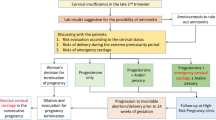Abstract
Objective
The purpose of the present study was to examine obstetric outcome of patients following conization and specifically the risk for preterm delivery (PTD).
Methods
A population-based study was performed comparing pregnancies in women following conization with those who had not undergone the procedure. Stratified analysis, using a multiple logistic regression model was performed to control for confounders.
Results
Out of 104,670 deliveries, 53 women (0.05%) had undergone conization. Most conizations were performed using loop electrosurgical excision procedure (LEEP). Using multivariable analysis, the following conditions were significantly associated with conization: advanced maternal age, PTD before the 34th week, low birth weight, and cervical incompetence with cerclage. Higher rates of perinatal mortality were noted in pregnancies of women with conization, but after controlling for PTD, the association lost its significance. The risk of PTD <34 weeks was significantly higher than the comparison group (OR 7.73 95% CI 3.77–15.85, p < 0.001). This association remained significant after controlling for confounders, such as cervical incompetence, smoking, maternal age, birth order and year of delivery (OR 2.8 95% CI 1.3–6.1, p = 0.008). When comparing pregnancy outcomes of women with and without cerclage due to cervical incompetence, no significant differences were documented.
Conclusions
A clear association exists between conization and PTD before the 34th week. This association persists after controlling for variables considered to coexist with PTD. Carful surveillance is required in pregnancies of women following conization for early detection of preterm contractions and PTD.

Similar content being viewed by others

References
Saslow D, Runowicz CD, Solomon D, Moscicki AB, Smith RA, Eyre HJ, Cohen C (2002) American Cancer Society Guidelines for the Early Detection of Cervical Neoplasia and Cancer. CA Cancer J Clin 52:342–362
Kyrgiou M, Koliopoulos G, Martin-Hirsch P, Arbyn M, Prendiville W, Paraskevaidis E (2006) Obstetric outcomes after conservative treatment for intraepithelial or early invasive cervical lesions: systemic review and meta-analysis. Lancet 367:489–498
Jancer N, Rakar S, Poljak M, Fujs K, KocJan BJ, Vrtacnik-Bokal E (2006) Efficiency of three surgical procedures in eliminating high-risk human papillomavirus infection in woman with precancerous cervical lesions. Eur J Gynecol Oncol 27:239–242
Mathevet P, Dargent D, Roy M, Beau G (1994) A randomized prospective study comparing three techniques of conization: cold knife, laser and LEEP. Gynecol Oncol 54:175–179
Mathevet P, Chemali E, Roy M, Darget D (2003) Long term outcome of a randomized study comparing techniques of conization: cold knife, laser and LEEP. Eur J Obstet Gynecol Reprod Biol 106:214–218
Crane JM, Delaney T, Hutchens D (2006) Transvaginal ultrasonography in the prediction of preterm birth after treatment for cervical intraepithelial neoplasia. Obstet Gynecol 107:37–44
Sadler L, Saftalas A, Wang W, Exeter M, Whittaker J, McCowan L (2004) Treatment for cervical intraepithelial neoplasia and risk of preterm delivery. JAMA 291:2100–2106
Samson SL, Bentley JR, Fahey TJ, McKay DJ, Gill GH (2005) The effect of loop electrosurgical excision procedure on future pregnancy outcome. Obstet Gynecol 105:325–332
Acharya G, Kjeldberg I, Hansen SM, Sorheim N, Jacobsen BK, Maltau JM (2005) Pregnancy outcome after loop electrosurgical excision procedure for the management of cervical intraepithelial neoplasia. Arch Gynecol Obstet 272:109–112
Cruickshank ME, Flannelly G, Campbell DM, Kitchener HC (1995) Fertility, pregnancy outcome following large loop excision of cervical transformation zone. Br J Obstet Gynecol 102(6):467–470
Klaritsch P, Reich O, Giuliani A, Tamussino K, Haas J, Winter R (2006) Delivery outcome after cold knife conization of the uterine cervix. Gynecol Oncol 103(2):604–607
Sietske M, Gustaaf A, Pieter H, Dick J (2001) Herman P: Final results of the cervical incompetence prevention randomized cerclage trial (CIPRACT): therapeutic cerclage with bed rest versus bed rest alone. Am J Obstet Gynecol 185:1106–1112
Hiems KP, Simhan HN (2007) Time from cervical conization to pregnancy and preterm birth. Obstet Gynecol 109(2):314–319
Tsikouras P, Galazios G, Zalvanos A, Bouzaki A, Athanasiadis A (2007) Transvaginal sonographic assessment of the cervix and preterm labor. Clin Exp Obstet Gynecol 34(3):159–162
Conflict of interest
None.
Author information
Authors and Affiliations
Corresponding author
Additional information
The work is supported by Grant from the Whitman family. Ben-Gurion University of the Negev, Center for Women’s Health Studies and Promotion. The work is performed to partly fulfill the MD requirements of Sharon Armarnik.
Rights and permissions
About this article
Cite this article
Armarnik, S., Sheiner, E., Piura, B. et al. Obstetric outcome following cervical conization. Arch Gynecol Obstet 283, 765–769 (2011). https://doi.org/10.1007/s00404-011-1848-3
Received:
Accepted:
Published:
Issue Date:
DOI: https://doi.org/10.1007/s00404-011-1848-3



